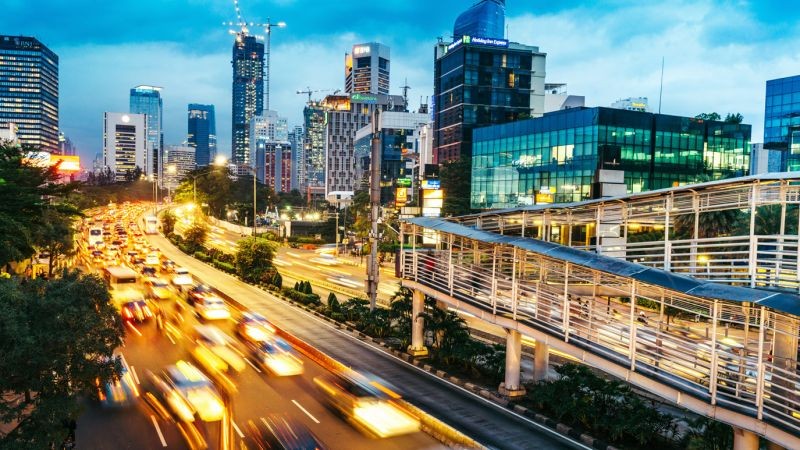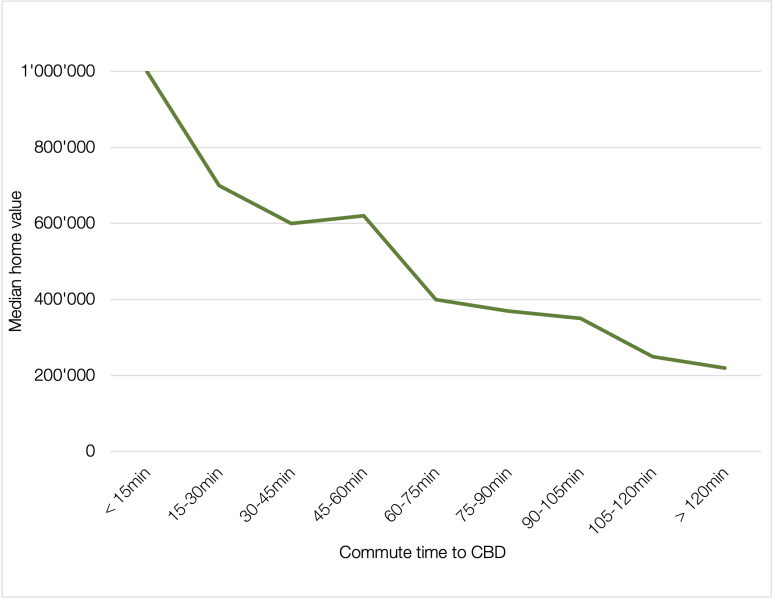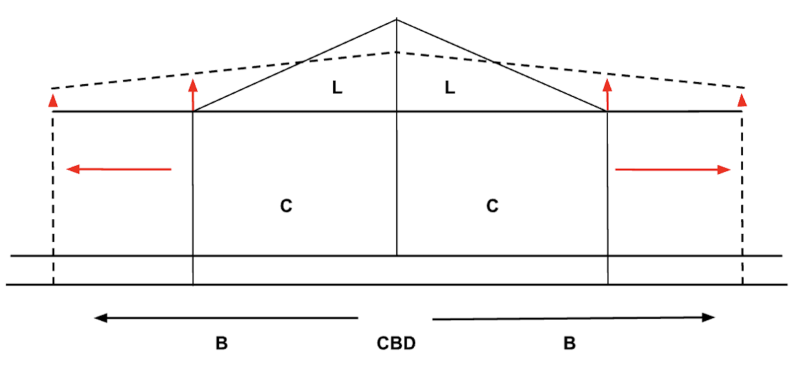Shifting gears: Autonomous vehicles and the evolution of urban landscapes
In the field of urban economics, it is well understood that real estate prices typically decline with increasing distance from Central Business Districts (CBDs). This relation is largely due to the higher cost and longer time associated with commuting from more distant locations, a key factor in property valuation. Current data shows an evident pattern in real estate prices relative to their proximity to urban centers, as illustrated by the example of Boston in Figure 1. However, the emergence and potential widespread adoption of Autonomous Vehicles (AVs) might soon alter this established price dynamic. By reducing commute time and the cost involved, AVs have the potential to significantly alter the way property values are determined in relation to CBDs.
Figure 1: Median home value by commute time in Boston
Source: Zillow
For several years now, prominent corporations including some of the largest automobile manufacturers and car hailing providers have pledged to launch self-driving cars. In 2017, Uber projected the deployment of an autonomous fleet by early 2018. Despite these bold declarations, as of 2024, we still find no Uber cars operating without a driver, and even Tesla cars, though technically capable of self-driving, are mandated to be operated by humans.
The landscape has shifted since these initial announcements. Accidents involving AVs have sparked public mistrust in what was previously heralded as an assured future. Meanwhile, various car manufacturers have begun incorporating autonomous driving features into their vehicles. Gradually, self-driving capabilities are becoming common, painting a picture of future cities dominated by AVs.
The timeline for this transformation remains uncertain and is dependent on the willingness of people and societies to adapt. Until then, we are likely to see a combination of autonomous and human-operated vehicles. Some countries, such as Singapore, the Netherlands, and Norway, are more prepared for the implementation of AVs, as stated by KPMG. However, many countries are still in the very early stages of developing and initiating regulations and infrastructure preparations necessary for a widespread introduction of AVs. A mass deployment of AVs in countries that are not adequately prepared for a controlled and well-regulated rollout could potentially lead to adverse effects on traffic flow, rather than benefiting a city. In fact, it is more likely to result in chaos. This lack of readiness could impede the realization of numerous advantages that the era of AVs promises.
On the other hand, in cities which are prepared and willing to embrace AVs, we can expect significant changes. Their current structure, centered around business districts and commuter routes, may become less critical or even obsolete. This opens up the potential for transformative shifts in urban planning, transportation networks, and overall mobility. The exact nature of these changes will depend on the specific circumstances of each city. According to the MIT Urban Mobility Lab, AVs stand to drastically reshape urban planning. They present a transformative opportunity for urban mobility.
Redefining urban spaces
The increased adoption of AVs could reduce the need for parking spaces in cities, allowing valuable urban areas to be repurposed for parks, housing, or commercial development. As the autonomous fleet expands, many cities may decide to decrease on-street and garage parking, detach development projects from parking requirements, and encourage the redevelopment of existing lots.
New York City serves as a prime example when illustrating the extensive amount of urban space consumed by parking areas, with approximately 3 million curbside parking spaces. If only 20 percent of the area is repurposed, it would yield a significant new development space of around 7 square kilometers, which is equivalent to nearly two Central Parks. This provides an opportunity for cities to efficiently repurpose land that was previously occupied by parking. From the repurposed parking spaces, a portion can be designated for new drop-off areas or other developments that support AVs, while the rest can be transformed into properties or amenities that create value for the city. This new-found space can help prevent overcrowding, create more housing opportunities, and enhance the overall appeal and value of the city and its real estate.
Steering suburban real estate trends
AVs are anticipated to surpass the performance of humanoperated vehicles, leading to enhanced traffic flow and diminished congestion. This improvement is largely due to the AVs' advanced communication capabilities with nearby vehicles and traffic management systems, which significantly reduce the potential for driving errors. Furthermore, the integration of AVs into car sharing and ride-hailing services, like Uber, is projected to make these services more affordable and efficient. As a result, individuals may be motivated to move from city centers to the suburbs, where real estate prices are often lower. The reliance on good public transportation options will be less critical due to the independence and affordability of AV transportation.
To assess the benefits of Avs from a more analytical approach, we turn to the general formula from which dwellers derive (land) utility:
Utility = Income + Amenities – Housing Cost – Transportation Cost
Analyzing the factors affecting land utility, AVs primarily impact amenities as well as transportation cost, where amenities are expected to increase and transportation cost to decrease. Thus, the overall utility within the CBD and the periphery is expected to increase over the years as AVs become established. However, the introduction of AVs could also lead to a shift in housing demand. As transportation becomes more efficient and affordable, living in the city center may become less of a necessity. Such a shift could potentially lead to urban sprawl, with increased development in suburban areas and a potential decrease in population density in the city center. This would reduce demand for housing in the CBD, exerting downward pressure on property prices as shown in Figure 2.
Figure 2: Potential effect of AV-induced transportation cost reduction on property prices. The introduction of Avs may level the land price gradient.
( L = Location rent, C = Construction rent, B = Distance to CBD, CBD = Central Business District) Source: Asia Green Real Estate
Figure 2 illustrates the impact of AVs on property prices within a monocentric urban framework. As the urban radius, denoted by 'B', expands outward from the CBD, there is a notable equalization of land cost across the cityscape. This effect is primarily due to decreased transportation cost and improved accessibility to amenities from suburban areas, which collectively enhance the utility of land on the periphery. Simultaneously, the utility within the CBD also sees incremental increases, but relatively less that the periphery. Hence, the price premium of CBD properties over their peripheral counterparts diminishes. Effectively, this shift toward a more balanced distribution of land cost reflects the dynamic interplay between urban sprawl and infrastructural evolution.
Future implications
As cities become more AV-ready, they will need to manage the repurposing of land currently used for parking, traffic flow, and the equitable distribution of AV benefits while minimizing negative effects such as increased traffic and urban sprawl. This will require collaboration between city planners, real estate developers, AV operators, and the public. While AVs promise substantial benefits, realizing these will require a well-regulated transition process. As we move towards this future, we must consider the potential impacts on urban life, including real estate prices and city living experiences.
Our complimentary publications inform you about current developments in the Asian real estate market and key trends in the real estate industry. Sign up to receive them automatically.


